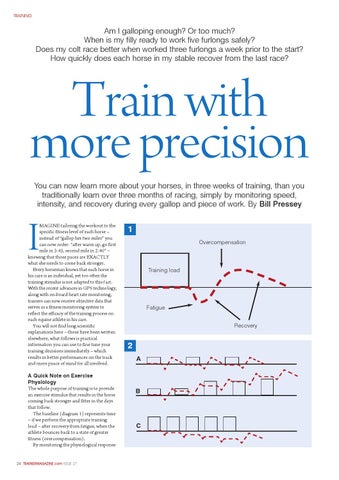OPTIMAL CONDITIONING ISSUE 27.qxd:Jerkins feature.qxd
20/8/09
20:15
Page 1
TRAINING
Am I galloping enough? Or too much? When is my filly ready to work five furlongs safely? Does my colt race better when worked three furlongs a week prior to the start? How quickly does each horse in my stable recover from the last race?
Train with more precision You can now learn more about your horses, in three weeks of training, than you traditionally learn over three months of racing, simply by monitoring speed, intensity, and recovery during every gallop and piece of work. By Bill Pressey
I
MAGINE tailoring the workout to the specific fitness level of each horse – instead of “gallop her two miles” you can now order: “after warm up, go first mile in 3:45, second mile in 2:40” – knowing that those paces are EXACTLY what she needs to come back stronger. Every horseman knows that each horse in his care is an individual, yet too often the training stimulus is not adapted to this fact. With the recent advances in GPS technology, along with on-board heart rate monitoring, trainers can now receive objective data that serves as a fitness monitoring system to reflect the efficacy of the training process on each equine athlete in his care. You will not find long scientific explanations here – those have been written elsewhere, what follows is practical information you can use to fine tune your training decisions immediately – which results in better performances on the track and more peace of mind for all involved. A Quick Note on Exercise Physiology The whole purpose of training is to provide an exercise stimulus that results in the horse coming back stronger and fitter in the days that follow. The baseline (diagram 1) represents time – if we perform the appropriate training load – after recovery from fatigue, when the athlete bounces back to a state of greater fitness (overcompensation). By monitoring the physiological response
24 TRAINERMAGAZINE.com ISSUE 27
1 Overcompensation
Training load
Fatigue Recovery
2 A
B
C
